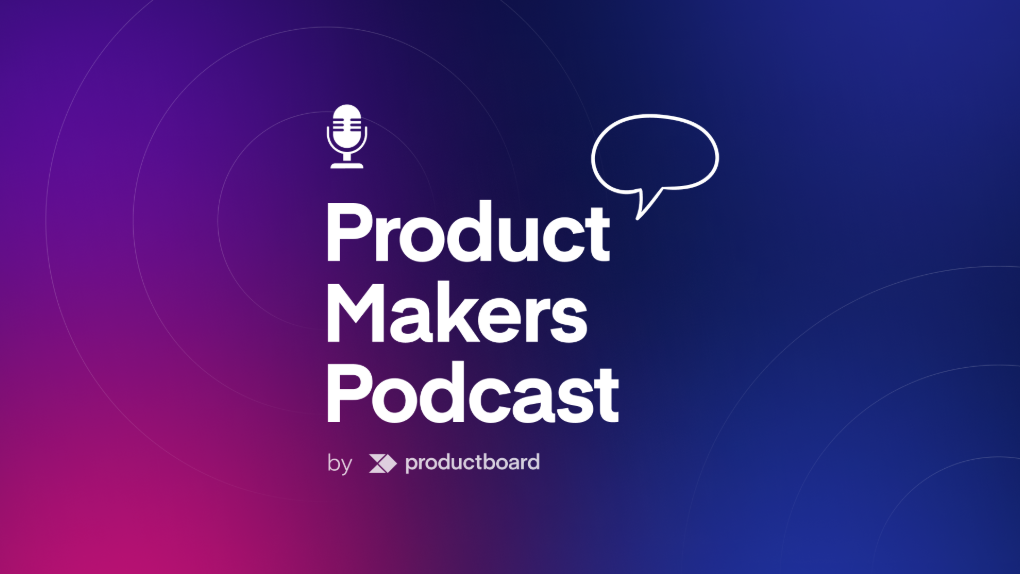How FigJam’s dedication to delight helped build a thriving design community
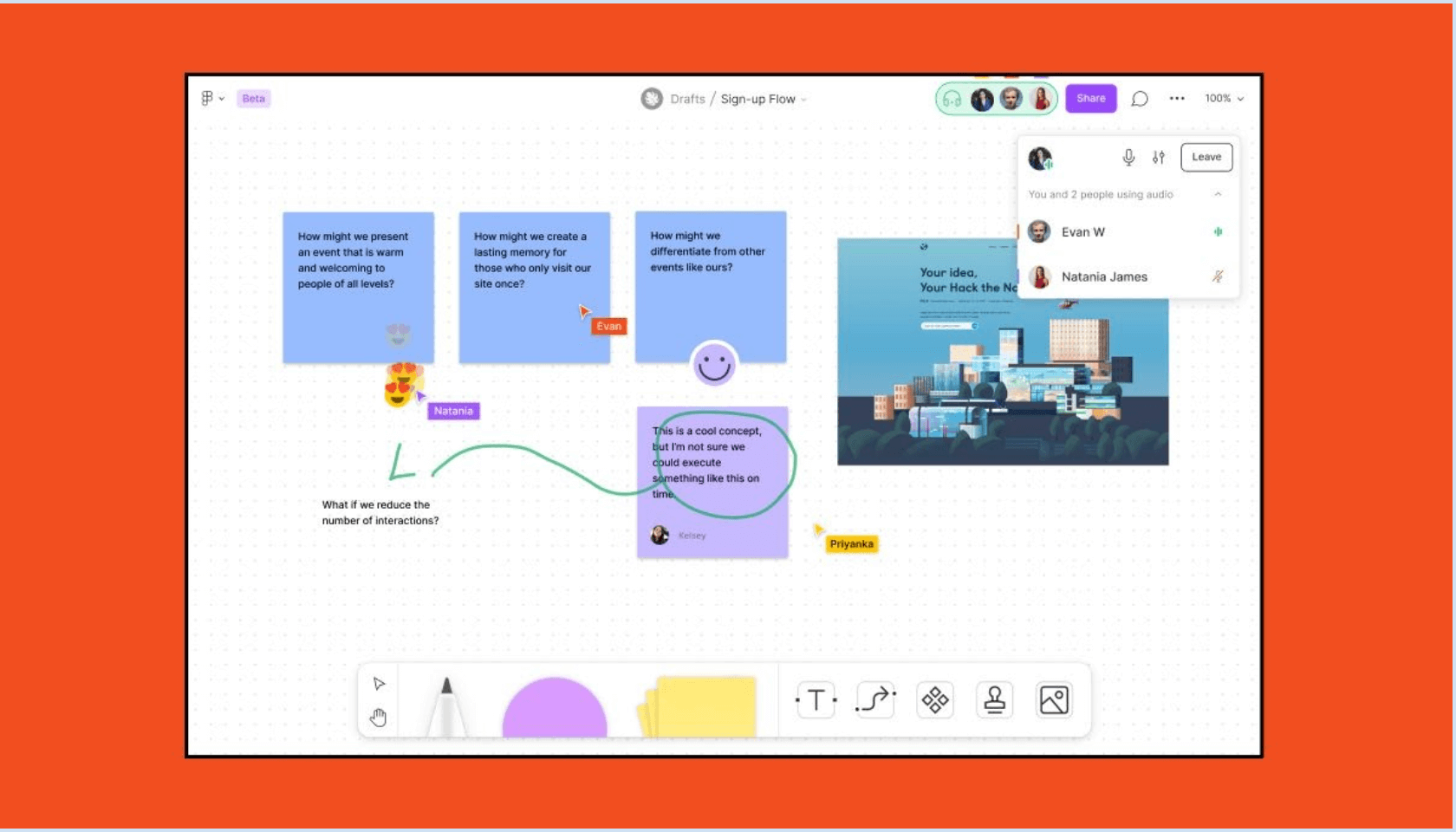
It was only after planting a flurry of star-shaped stamps on our shared FigJam canvas that I noticed each star was angled a little differently.
Just like an actual stamp, explains Emily Lin, the lead product manager for Figma’s second major launch: FigJam. “We went back and forth on the exact angles,” she laughs as she places an assortment of her favorite stamps beside mine from halfway across the country.
That attention to user experience is what sets FigJam apart from other collaboration tools. At its core, FigJam is an online whiteboard for teams to ideate and brainstorm together—think diagramming, but multiplayer. Sure, Figjam includes the ubiquitous digital sticky notes, drawing tools, and pre-built shapes from other diagramming tools—but the real-time chat, stamps, emojis, and “cursor chat” bring a new layer of collaboration to a traditionally siloed exercise.
While other design tools might turn a blind eye to things like stamp angles, Lin and her talented team of designers and engineers understand that attention to detail is the cornerstone of the thriving design community that Figma has built.
We wanted to learn more about how the team built and launched FigJam, and Lin was kind enough to share some of her experiences and lessons learned—but first, it’s essential to understand the origins of FigJam.

A collaboration tool built for uncertain times
The idea for FigJam originated in the summer of 2020—the height of the pandemic. Like much of the tech world, the Figma team was busy navigating the shift to fully remote work. Designers, developers, researchers, and PMs typically used to face-to-face design crits and product syncs were suddenly thrust into exclusively working through a screen.
By this point, Lin had been with Figma for about a year, working on everything from fonts and typography to Auto-Layout. Her team had always dogfooded Figma to enable remote design collaboration, but the group found themselves leaning on Figma for use cases the designers had never anticipated. Zoom calls became collaborative design sessions where teams worked through problems together in real-time. The company even hosted a remote murder-mystery offsite inside Figma.
Gradually, Lin began noticing other companies and individuals—not just designers—using Figma the same way. “On Twitter, people would share GIFs of team hangouts, icebreakers, birthday cards. It was cool to see.”
Time for a little thread: Some teams pass around a physical birthday card, at Figma we have a long-standing tradition of making collaborative cards and getting everyone to fill them with fun stuff; everything ranging from heartfelt messages, images, to jokes and funny stories. pic.twitter.com/V1iGqs6hP9
— Tom Lowry (@negativespaceca) April 13, 2020
All this made the team realize there was a ton of opportunity for having a Figma-like space where even people who aren’t familiar with design tools could join designers and work collaboratively. The idea for FigJam was born, and the team began prototyping immediately.
Our inspiration [for FigJam] really came from that need that we saw from both ourselves and our community.
Doubling down on what was already working
Every product decision holds some level of uncertainty. Sometimes the risks are low, like adding a new feature to an established product. Other times—particularly when transitioning from a single-product to a multi-product company, as Figma did with FigJam—the risks around usability, feasibility, viability, and value mean extensive product discovery before diving into development.
Fortunately for Lin, Figma had already given them a shortcut. Watching teams using Figma in the wild meant Lin and her team were already reasonably confident in the demand for a product like FigJam.
This confidence meant that the team could dedicate much of their design exploration to nailing the two critical use cases Lin had seen customers hacking Figma to do: diagramming and brainstorming. While Figma let users create shapes, connecting those shapes was complex, and moving shapes around the canvas was a chore.
“We looked at a lot of examples of brainstorms and diagrams that people were building in Figma and other tools. Then we just knocked out the key user journeys on our side—like when you make a diagram, you need different kinds of shapes, and you need some way to connect them, and you need those connectors to be somewhat smart, so you don’t have to do a bunch of manual work when you want to make adjustments.”
While Figma was designed primarily for professional designers, FigJam needed to be effortless for entire product teams to use together—from engineers and researchers to product managers and marketing folks. At the same time, interoperability remained at the top of Lin’s mind: with FigJam being a great space for ideation and brainstorming, and Figma being the perfect tool for moving towards design and iteration, the two products needed to work hand-in-hand from the very beginning.
Fortunately, the team could port over the most popular collaborative features from Figma, allowing seamless movement of designs and libraries between the two products without compromising ease-of-use. “You can copy a diagram from FigJam and paste it into Figma, so you have the diagram to reference alongside the user flows you might be building,” Lin explains. “And similarly, you can take UI pieces from Figma and paste them into FigJam to do design crits and give feedback.”
This deep integration made FigJam an easy sell for the designers already used to working in Figma—and made it a no-brainer for the developers, marketers, and product managers who worked alongside them. Sticking with their core area of expertise also meant the team could launch on schedule in April of 2021 without experiencing any significant technical hurdles—an impressive feat given FigJam’s huge ambitions.
The importance of dogfooding
Beta testing is a common practice among software teams. For a standalone product launch like FigJam, though, beta testing can make it challenging to keep the product under wraps until the launch date. To get enough testing in for their product, then, Lin relied heavily on internal testing—or dogfooding—before launching FigJam, along with feedback from a small group of trusted companies like Discord and Square who had shared feedback in the past.
About three months before the public launch, Lin put Figjam up for both Figma employees and existing Figma evangelists (under NDA) to play with.
“We put it up a little earlier than we felt ready. We were super nervous about it, but we also knew we had to get feedback from people to iterate and make sure FigJam hit all the things we wanted to hit. ”
Lin laughed when she recalled the response to one feature in particular: changing the color of the sticky notes. When they first made FigJam available for testing, the team hadn’t yet added the ability to set the color of sticky notes manually. Instead, colors were assigned at random each time the user refreshed the page.
“We were immediately bombarded with questions from people asking how they can change the color of the sticky notes,” she exclaims. “There was about a week where people were just aggressively refreshing, saying things like ‘Oh, I don’t personally like this color, and now I have to refresh until I get my favorite color.’
Despite the product missing many of the final touches, opening up FigJam for dogfooding early in the development cycle meant Lin and the team could build a streamlined feedback pipeline to help shape the direction of the product. The team hosted an open Slack channel where employees and beta customers could add suggestions or workshop use cases. Every week, Lin also shared a list of all the new features the team had added. “It helped build momentum and show the company that we’re listening to their feedback. People would give feedback; they’d see that it impacted our roadmap, and then they’d give us more feedback.”
That open line of feedback proved motivating for beta users and the product team alike. “There was a noticeable mindset shift [after we launched internally]—everyone on the team got so energized. It was also super motivating for me personally, to see people using the product and be able to make adjustments to help them.”
Adding the “Figma touch”
In his acclaimed book Designing for Emotion, Aaron Walker describes a hierarchy of user needs every product must meet. He says every product must meet four levels of usefulness:
- Functional (solving a problem)
- Reliable (running without issue)
- Usable (easy to use, learn, and remember)
- Pleasurable (being a joy to use)
Since first launching in 2016, Figma has developed a reputation for building functional and joyful products, bringing joy to an often lonely design process. “Sometimes you’d run into someone in a Figma file,” Lin shares, “and people will aggressively wave their cursor to say hi, or someone will add a text box to use as a makeshift chat.”
“One of our Figma values is ‘Love your craft.’ The polish and the little details are super important to us as a company—it’s something that all Figmates have internalized.”
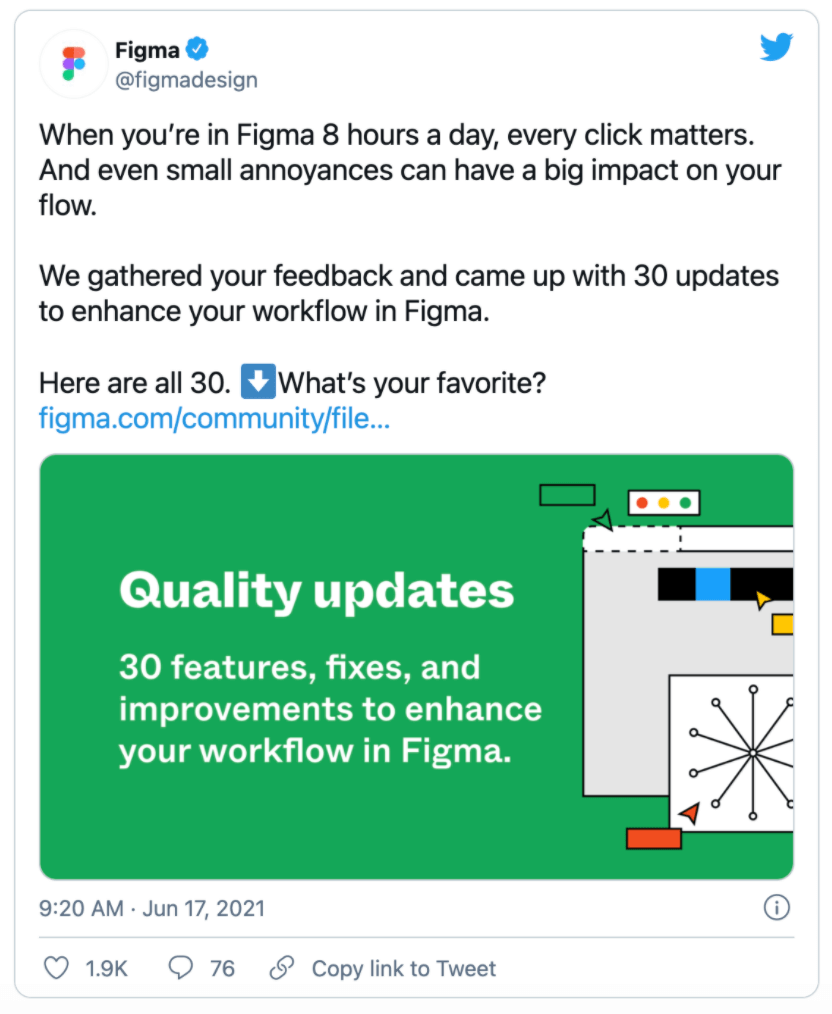
Those sporadic moments of delight were a big part of what made Figma attractive to so many teams—and the team wanted to carry that same feeling into FigJam as well. While the initial pitch for FigJam only included the basics, the team added a handful of features late in the development process to delight users and brought the “Figma touch” to FigJam.
Take cursor chat, for example. Right-clicking the canvas or tapping the slash key opens a text box prompting the user to say something. Their entry then “sticks” to their cursor for a few seconds for everyone to read. Adding cursor chat brought a new element of interactivity to FigJam documents. “When we started running our PM team meetings in FigJam, we couldn’t tell if people were listening or if they were just multitasking on Slack. But with cursor chat, the engagement in these meetings went up a lot—people would comment using cursor chat while other people were talking.”
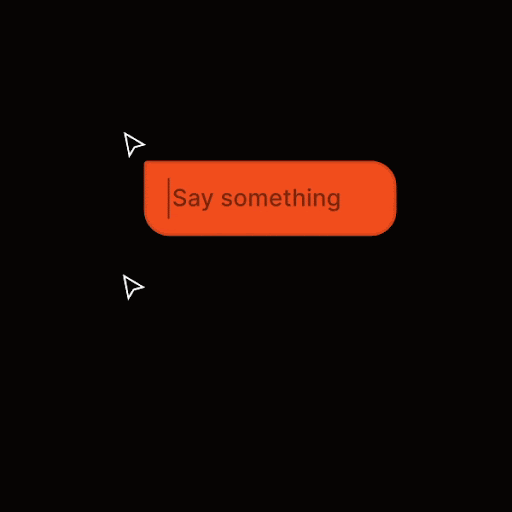
Two other late-breaking delighters were stamps and emoting. A quick tap on the E key opens a two-sided wheel. Click an emoji on the top side of the wheel, and a fountain of emojis bubbles up for everyone to see. The bottom side of the wheel includes a range of stamps users can add to any document, ranging from design elements like arrows and speech bubbles to animated stamps submitted by members of the Figma community.
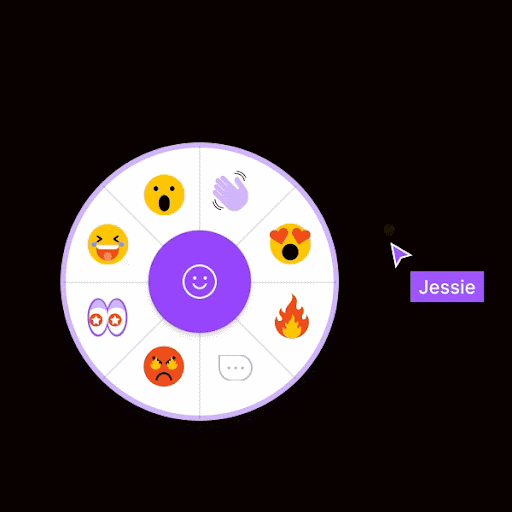
Lin uses both features heavily with her team to share synchronous feedback during calls, vote for features during brainstorming sessions, or even play a quick game of Connect 4. And while elements like emoting are often the first to be cut from an initial release, Lin’s glad she pushed to include them.
“One of our Figma values is ‘Love your craft,’” Lin shares. “The polish and the little details are super important to us as a company—it’s something that all Figmates have internalized. When added up, it does make a huge difference in how people experience a product and how a good product feels.”
How FigJam uses FigJam to keep the team coordinated
Figma is still a comparatively small company, so launching the company’s second primary product required a significant commitment from across the entire organization. “The bulk of the engineering work didn’t happen until the six months leading up to launch,” Lin shares. “I was the primary PM working on the tool and the creative side, and we had different PMs working on different parts of the product, like onboarding and our enterprise-facing functionality. Our product marketing manager, counterpart user researcher, and data scientist were also super-involved throughout the process.”
Keeping all those people pointed towards the same goal took a concerted effort. The PM team holds a weekly team meeting to share what’s going on across the product portfolio. The team also held weekly cross-functional “coordinator meetings” throughout FigJam’s development cycle, where PMs met with stakeholders from engineering and design along with product marketing, user research, and occasionally support and product education.
“Sometimes the meetings are more tactical, and we’re talking about things like the timing of feature launches,” Lin explains. “We also use this meeting to talk about other topics that are pressing but may not be a weekly thing, like our FigJam strategy for the rest of the year.”
Of course, with the company now working remotely, much of the teams’ coordination centers around FigJam. “I’m personally a visual thinker,” Lin shares, “so FigJam helps me game out the next couple of months.”
Four lessons product managers can learn from FigJam
Lin shared plenty of helpful takeaways during our conversation—here are a few of the most valuable:
Lesson #1: Your most valuable product ideas are often hiding in plain sight
The inspiration behind FigJam came not from user research but simply from watching how people were molding existing products to meet their needs. If Lin had been looking at Figma purely as a design tool, she would likely have missed the opportunity to build FigJam entirely.
- What are some non-traditional ways people might be using your product to meet their needs? How might you integrate these use cases into your product?
- That said, make sure that you are working on problems that need to be solved. For example, how significant is the pain that your users are experiencing? How much value will tackling the pain truly add?
Lesson #2: Get product feedback early
Whether you share your early-stage products and features with a select list of evangelists or simply make it available to employees for testing, beta testing before you feel too comfortable lets you see what’s working (and what’s not working), giving you valuable insights into how to best meet user needs.
- Even the most insightful feedback can only be valuable if you turn it into action. For example, where will you collect user feedback on your new product from colleagues and customers? How can you turn that feedback into actionable insights?
- Like Lin’s sticky note colors, not every feature must be 100% ready when launching your beta test. Is your feature a must-have, or can it wait until after launch?
- Closing the feedback loop with beta users can help build momentum and show them you’re listening to their feedback. Consider sharing “internal release notes” each week or month to help guide testers to the features you’d like them to try.
Lesson #3: Ensure every new feature follows a cohesive product strategy
Lin didn’t try to reinvent the wheel with FigJam. Instead, the company stuck to its core area of expertise—collaborative design tools. This had the immediate benefit of making it easier to reach the target audience for FigJam while taking the company one step further toward their strategic product goals of bringing teams together from start to finish.
It also meant the development team could leverage much of the technical expertise and user knowledge they had gained from building Figma. Getting data scientists, product marketers, designers, and developers in the same room from early on kept the entire company pushing in the same direction.
- Think about your last big product or feature launch. Did it move you closer to your strategic objectives, or was it based on gut feel?
- The key to building a successful product roadmap is collaboration. How can you get the right people involved as early as possible?
Lesson #4: A little delight goes a long way
The community response to Figjam has been almost universally positive. And for a company like Figma, where delight is a core element of their brand, adding features like emoting and cursor chat late in the game might have taken more effort, but the payoff was huge.
- Don’t just consider core business objectives, such as revenue, when creating your product strategy. Instead, follow the Kano model and make sure you include a balanced mix of must-haves, performance features, and delighters to take your product to the next level.
- How can you share your users’ delight with your team and with your customers? For example, Figma turns unexpected use cases into Twitter threads to inspire people to use their products differently.
Be bold and love your craft
“Design isn’t just about UI design and tweaking pixels,” Lin shares as we close our call. “It’s about the entire design and development process—like the ideation that comes before and the developer handoff that comes after.”
Launching FigJam brings Figma one step closer to achieving its mission of making design accessible to everyone. Features like cursor chat and emoting make interacting with both the product and with other users a delight, bringing a much-needed moment of joy and rapport to the often-impersonal world of remote work.
Despite the apparent success of Figjam, Lin remains humble. “One of our company values is to grow as you go, and our approach to building new products is similar. There’s still a lot we want to do, and we’re pretty ambitious here.”





